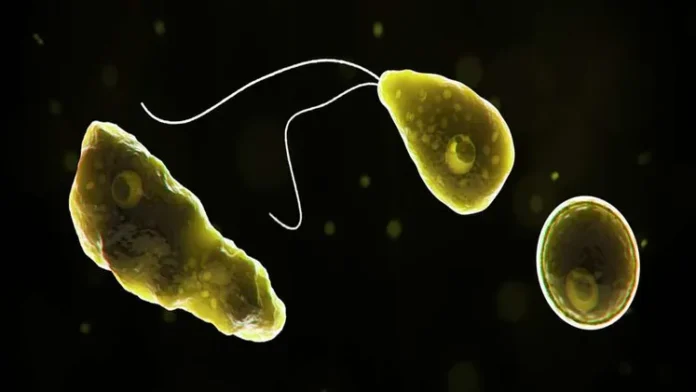Introduction
As sunseekers head toward California’s serene lakes and warm streams, few are aware of a microscopic menace thriving beneath the surface. This invisible threat doesn’t just cause minor illness—it attacks the brain, often with fatal consequences. The alarm surrounding the brain-eating amoeba has grown louder across the Golden State, and understanding this peril is no longer a matter of curiosity, but survival.
What Is the Brain-Eating Amoeba?
Scientific Name and Classification
Known scientifically as Naegleria fowleri, the brain-eating amoeba is a thermophilic (heat-loving) microorganism. It belongs to the phylum Percolozoa and is classified as a free-living amoeba. Despite being rare, its notoriety stems from its horrifying lethality and rapid course of destruction once inside the human host.
How It Invades the Human Body
The amoeba typically resides in warm freshwater. When contaminated water enters the nose—often during swimming, diving, or nasal irrigation—the amoeba can travel along the olfactory nerve into the brain. There, it causes a condition called Primary Amoebic Meningoencephalitis (PAM), which is almost always fatal.
Why California? Understanding the Geographic Risk
Warm Freshwater Environments
California’s geography is ripe for the amoeba’s proliferation. Lakes, hot springs, and even poorly maintained water parks become breeding grounds during summer months when temperatures soar. The amoeba thrives in water temperatures between 80°F and 115°F—conditions commonly found throughout Southern and Central California.
Climate Change and Its Role
Rising global temperatures and prolonged droughts concentrate water sources and increase warmth, extending the amoeba’s seasonal activity. Climate change is not only fueling wildfires and water shortages—it’s also widening the habitat for deadly microbes. California, with its vast outdoor recreation culture, becomes an unintended testing ground for these ecological consequences.
Notable Cases in California
Timeline of Confirmed Infections
While infections remain rare, they are real. In recent years, isolated cases have emerged in counties such as San Bernardino and Inyo. In 2023, a young boy tragically died after swimming in Lake Elsinore. His death sent shockwaves through the local community and reignited the conversation about freshwater safety.
Media Response and Public Reactions
Media coverage, often dramatic and fear-driven, amplifies the public scare. Headlines like “Deadly Amoeba Claims Another Life” spur anxiety but also encourage awareness. Parents pull their children from summer camps, and local governments are pressured to shut down swimming spots or install warning signs.
Symptoms and Progression of the Infection
Early Warning Signs
Initial symptoms typically appear within two to five days of exposure and resemble common viral infections: headache, fever, nausea, and vomiting. These signs are deceptive, often delaying a proper diagnosis until it’s too late.
Fatal Progression and Medical Challenges
Once the amoeba reaches the brain, the destruction is swift. Confusion, seizures, hallucinations, and coma follow. Death usually occurs within a week. The challenge lies in the rapidity of its assault and the difficulty in detecting PAM before irreversible damage is done.
How Infection Happens: The Entry Route
Nose as a Gateway
Naegleria fowleri must enter through the nose to be deadly. Ingesting contaminated water is harmless to the stomach, but the nasal cavity provides direct access to the central nervous system. This unique vulnerability highlights how ordinary activities like diving or forceful splashing can turn deadly.
Activities That Increase Risk
High-risk behaviors include swimming in untreated hot springs, diving in stagnant lakes, using tap water for nasal rinses (such as with neti pots), and even jumping into heated backyard ponds. The amoeba cannot survive in salt water or well-maintained chlorinated pools, but it thrives in the lukewarm, fresh, and untreated.
Prevention Tips for California Residents and Tourists
Precautions for Swimmers
Avoid swimming in warm freshwater during peak summer. If you must, wear nose clips and avoid submerging your head. Refrain from stirring up sediment where the amoeba typically dwells.
Safe Water Practices
Use only distilled, sterile, or previously boiled water for nasal rinsing. Homeowners with private water systems should regularly disinfect tanks and test water quality. Authorities recommend posting cautionary signage near recreational water bodies with a history of risk.
Medical Response and Limitations
Treatment Protocols
There is no guaranteed cure for PAM. However, some treatments—such as the antifungal drug amphotericin B, the investigational drug miltefosine, and induced hypothermia—have shown limited success. The key is immediate detection and aggressive therapy.
Why Recovery Is So Rare
The infection advances at breakneck speed. By the time it is diagnosed, the amoeba has often caused catastrophic brain inflammation. Only a handful of patients worldwide have survived, and they did so through early intervention and extraordinary medical support.
The Role of Public Health Authorities
Monitoring and Reporting
California’s Department of Public Health has begun more rigorous surveillance, especially after each reported case. They also work in tandem with the Centers for Disease Control and Prevention (CDC) to trace the source and update risk guidelines.
Education and Community Awareness
Public advisories, school outreach, and training local physicians on recognizing PAM are part of the strategy. Water agencies are also investing in public education, stressing behavioral prevention over paranoia.
Looking Ahead: Scientific Research and Hope for the Future
Current Studies and Innovations
Scientists are studying Naegleria fowleri‘s genome to identify weaknesses. Some research focuses on nanoparticles that could target the amoeba more effectively. Others explore rapid testing kits that can detect its presence in water before human exposure occurs.
Toward a Vaccine or Effective Cure
While no vaccine exists yet, efforts to develop immunological defenses are underway. The long-term hope is to create an accessible treatment protocol that can reduce mortality. Until then, early diagnosis and awareness remain the most potent weapons.
Conclusion
The fear surrounding the brain-eating amoeba in California is justified, but not insurmountable. Though rare, the infection is deadly. But knowledge is power. With informed caution, smart swimming habits, and public vigilance, Californians can safely enjoy their waters while keeping this microscopic predator at bay.
















